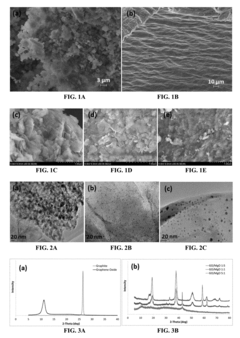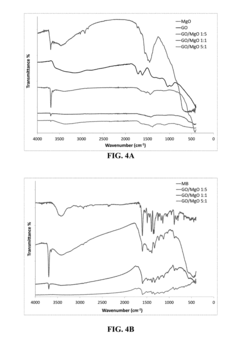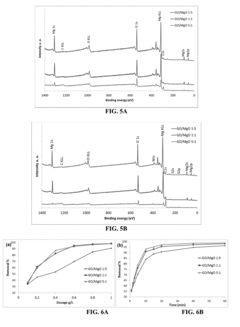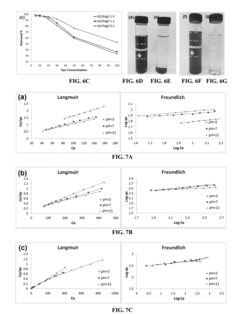How to Tackle Environmental Pollutants with Graphene Oxide?
Graphene Oxide in Environmental Remediation: Background and Objectives
Graphene oxide has emerged as a promising material for environmental remediation due to its unique properties and versatile applications. The field of environmental pollution control has been seeking innovative solutions to address the growing challenges of contamination in air, water, and soil. Graphene oxide, a two-dimensional carbon nanomaterial derived from graphite, has garnered significant attention in recent years for its potential to tackle various environmental pollutants effectively.
The development of graphene oxide technology can be traced back to the early 2000s when researchers began exploring the properties of graphene-based materials. As the understanding of graphene oxide's structure and characteristics improved, its potential for environmental applications became increasingly apparent. The material's large surface area, high adsorption capacity, and ability to be functionalized with various chemical groups make it particularly suitable for removing a wide range of pollutants from different environmental matrices.
The primary objective of utilizing graphene oxide in environmental remediation is to develop efficient, cost-effective, and sustainable methods for pollutant removal and degradation. Researchers aim to exploit the material's unique properties to address persistent environmental challenges, such as the removal of heavy metals, organic contaminants, and emerging pollutants from water and soil. Additionally, there is a growing interest in exploring graphene oxide's potential for air purification and gas sensing applications.
The evolution of graphene oxide technology in environmental remediation has been marked by several key milestones. These include the development of various synthesis methods to produce high-quality graphene oxide, the exploration of different functionalization techniques to enhance its selectivity and efficiency, and the integration of graphene oxide with other materials to create advanced composite adsorbents and catalysts.
As the field progresses, researchers are focusing on overcoming challenges related to scalability, cost-effectiveness, and environmental safety of graphene oxide-based remediation technologies. The ultimate goal is to transition from laboratory-scale experiments to practical, large-scale applications that can make a significant impact on environmental pollution control.
The growing interest in graphene oxide for environmental remediation is driven by the urgent need for innovative solutions to address global environmental challenges. As regulations become more stringent and public awareness of environmental issues increases, the demand for effective pollution control technologies continues to rise. Graphene oxide holds the promise of providing versatile and efficient solutions to meet these evolving needs in the field of environmental protection and sustainability.
Market Analysis for Graphene Oxide-based Pollution Solutions
The market for graphene oxide-based pollution solutions is experiencing significant growth, driven by increasing environmental concerns and stringent regulations worldwide. As governments and industries seek innovative approaches to tackle environmental pollutants, graphene oxide has emerged as a promising material with diverse applications in pollution control and remediation.
The global market for graphene-based products, including graphene oxide, is projected to expand rapidly in the coming years. This growth is particularly evident in the environmental sector, where graphene oxide's unique properties make it an attractive option for addressing various pollution challenges. The material's high surface area, excellent adsorption capacity, and ability to be functionalized for specific pollutants contribute to its rising demand in water treatment, air purification, and soil remediation applications.
In the water treatment segment, graphene oxide-based solutions are gaining traction for their effectiveness in removing heavy metals, organic pollutants, and emerging contaminants from water sources. The increasing scarcity of clean water resources and the need for advanced water purification technologies are driving the adoption of graphene oxide membranes and adsorbents in both industrial and municipal water treatment facilities.
Air pollution control represents another significant market opportunity for graphene oxide-based solutions. With urban air quality deteriorating in many parts of the world, there is a growing demand for advanced air filtration systems. Graphene oxide's ability to capture particulate matter, volatile organic compounds, and other airborne pollutants positions it as a valuable material for developing high-performance air filters and purification devices.
The soil remediation market is also showing interest in graphene oxide-based technologies. As industrial activities and improper waste disposal continue to contaminate soil resources, there is an increasing need for effective soil treatment methods. Graphene oxide's potential in immobilizing heavy metals and degrading organic pollutants in soil has attracted attention from environmental agencies and remediation companies.
Geographically, Asia-Pacific is expected to be a key market for graphene oxide-based pollution solutions, driven by rapid industrialization, urbanization, and growing environmental awareness in countries like China and India. North America and Europe are also significant markets, with stringent environmental regulations and a strong focus on sustainable technologies driving adoption.
Despite the promising market outlook, challenges such as high production costs and scalability issues need to be addressed to facilitate widespread commercialization of graphene oxide-based pollution solutions. As research and development efforts continue to optimize production processes and enhance the material's performance, the market is poised for substantial growth in the coming years.
Current Challenges in Graphene Oxide Environmental Applications
Despite the promising potential of graphene oxide (GO) in environmental applications, several significant challenges hinder its widespread implementation and effectiveness in tackling environmental pollutants. These challenges span across technical, economic, and environmental domains, requiring comprehensive research and development efforts to overcome.
One of the primary technical challenges is the scalability of GO production. While laboratory-scale synthesis of high-quality GO is well-established, scaling up to industrial levels while maintaining consistent quality and properties remains problematic. The Hummers method, commonly used for GO synthesis, involves hazardous chemicals and generates toxic gases, posing safety and environmental concerns in large-scale production.
Another critical issue is the aggregation and restacking of GO sheets in aqueous solutions, which significantly reduces their effective surface area and, consequently, their adsorption capacity for pollutants. This phenomenon limits the long-term stability and efficiency of GO-based environmental remediation systems, particularly in water treatment applications.
The selectivity of GO towards specific pollutants also presents a challenge. While GO demonstrates high adsorption capacity for various contaminants, achieving selective removal of target pollutants in complex environmental matrices remains difficult. This lack of selectivity can lead to inefficient use of GO materials and potential interference from competing species in real-world applications.
The recovery and regeneration of GO after pollutant adsorption pose additional challenges. Effective methods for separating GO from treated water and regenerating its adsorption capacity without significant loss of performance are crucial for sustainable and economically viable applications. Current regeneration techniques often involve energy-intensive processes or the use of chemicals that may introduce secondary pollution.
Environmental concerns regarding the potential toxicity and long-term ecological impacts of GO itself represent another significant challenge. The small size and high surface reactivity of GO nanoparticles raise questions about their bioaccumulation and potential harmful effects on aquatic ecosystems. Ensuring the complete removal or containment of GO after treatment is essential to prevent unintended environmental consequences.
Cost-effectiveness remains a major hurdle in the widespread adoption of GO-based environmental solutions. The current production costs of high-quality GO are relatively high, making it less competitive compared to conventional treatment technologies. Developing more economical synthesis methods and optimizing GO performance to reduce the required dosage are crucial for commercial viability.
Lastly, the lack of standardized characterization and testing protocols for GO materials in environmental applications hinders consistent performance evaluation and regulatory approval. Establishing uniform standards for GO quality, safety, and efficacy in pollutant removal is essential for building trust among stakeholders and facilitating broader implementation.
Existing Graphene Oxide-based Pollutant Removal Techniques
01 Graphene oxide for environmental pollutant removal
Graphene oxide is utilized in various applications for the removal of environmental pollutants. Its high surface area and unique properties make it an effective adsorbent for contaminants in water and air. Graphene oxide-based materials can be engineered to target specific pollutants, improving the efficiency of environmental remediation processes.- Graphene oxide for environmental pollutant removal: Graphene oxide is utilized in various applications for the removal of environmental pollutants. Its high surface area and unique chemical properties make it an effective adsorbent for contaminants in water and air. Graphene oxide-based materials can be engineered to target specific pollutants, improving the efficiency of environmental remediation processes.
- Graphene oxide-based sensors for pollutant detection: Graphene oxide is employed in the development of highly sensitive sensors for detecting environmental pollutants. These sensors can detect various contaminants in air and water at low concentrations, enabling rapid and accurate environmental monitoring. The electrical and optical properties of graphene oxide are exploited to create responsive and selective sensing platforms.
- Graphene oxide composites for enhanced pollutant removal: Composite materials incorporating graphene oxide are developed to enhance the removal of environmental pollutants. These composites combine the adsorptive properties of graphene oxide with other materials to improve selectivity, stability, and regeneration capabilities. Such composites find applications in water treatment, air purification, and soil remediation.
- Functionalized graphene oxide for specific pollutant targeting: Graphene oxide is functionalized with various chemical groups to target specific environmental pollutants. This functionalization enhances the selectivity and efficiency of pollutant removal processes. Tailored graphene oxide materials can be designed to address particular environmental challenges, such as heavy metal removal or organic contaminant degradation.
- Graphene oxide in photocatalytic degradation of pollutants: Graphene oxide is utilized in photocatalytic systems for the degradation of environmental pollutants. When combined with photocatalysts, graphene oxide enhances the efficiency of pollutant degradation under light irradiation. This approach is particularly effective for the treatment of organic pollutants in water and air, offering a sustainable solution for environmental remediation.
02 Graphene oxide-based sensors for pollutant detection
Graphene oxide is employed in the development of highly sensitive sensors for detecting environmental pollutants. These sensors can detect various contaminants in air and water with high accuracy and low detection limits. The unique electronic properties of graphene oxide allow for rapid and reliable sensing of pollutants in environmental monitoring applications.Expand Specific Solutions03 Graphene oxide composites for water treatment
Composite materials incorporating graphene oxide are developed for water treatment applications. These composites combine the adsorption properties of graphene oxide with other materials to enhance pollutant removal efficiency. The composites can be used in filtration systems, membranes, and other water purification technologies to address various water pollution issues.Expand Specific Solutions04 Functionalized graphene oxide for selective pollutant removal
Graphene oxide is functionalized with various chemical groups to enhance its selectivity towards specific environmental pollutants. This functionalization improves the adsorption capacity and specificity of graphene oxide-based materials for target contaminants. The tailored surface chemistry allows for more efficient removal of pollutants in complex environmental matrices.Expand Specific Solutions05 Graphene oxide in air purification systems
Graphene oxide is incorporated into air purification systems to remove airborne pollutants and improve indoor air quality. The material's high surface area and adsorption properties make it effective in capturing particulate matter, volatile organic compounds, and other air contaminants. Graphene oxide-based air filters and purifiers offer enhanced performance compared to conventional filtration materials.Expand Specific Solutions
Key Players in Graphene Oxide Research and Production
The field of tackling environmental pollutants with graphene oxide is in a rapidly evolving stage, characterized by intense research and development activities. The market size for this technology is expanding, driven by increasing environmental concerns and stringent regulations. While the technology shows promise, its maturity level varies across applications. Companies like William Marsh Rice University, Northwestern University, and Shandong University are at the forefront of research, developing innovative solutions. Industry players such as Cabot Corp. and LG Electronics, Inc. are also investing in this technology, indicating its potential for commercial applications. The competitive landscape is diverse, with academic institutions, research centers, and corporations all contributing to advancements in this field.
Advanced Environmental Technologies LLC
Cabot Corp.
Innovative Graphene Oxide Modifications for Enhanced Pollutant Adsorption
- Development of graphene oxide/magnesium oxide nanocomposites with varying weight ratios (10:1 to 1:10) that settle in aqueous solutions, allowing for efficient removal of organic molecules through sonication and subsequent separation without the need for a magnetic field.
- A sophisticated water and air purification system is developed, utilizing a robust filtration system with a porous matrix immobilizing functionalized GO NPs, integrated with a flow control mechanism, pre-filter, and real-time monitoring, ensuring efficient contaminant and pathogen removal, and featuring periodic GO NP replenishment for sustained performance.
Environmental Impact Assessment of Graphene Oxide Usage
The environmental impact assessment of graphene oxide usage is a critical aspect of its application in tackling environmental pollutants. Graphene oxide, with its unique properties and high surface area, offers promising solutions for environmental remediation. However, its potential ecological effects must be carefully evaluated.
One primary concern is the potential release of graphene oxide into aquatic ecosystems. Studies have shown that graphene oxide can interact with various aquatic organisms, potentially affecting their growth, reproduction, and overall health. The small size of graphene oxide particles allows them to penetrate cell membranes, potentially causing oxidative stress and cellular damage. Long-term exposure effects on aquatic ecosystems remain uncertain and require further investigation.
In terrestrial environments, the impact of graphene oxide on soil microorganisms and plant growth is another area of concern. While some studies suggest that graphene oxide can enhance plant growth by improving nutrient uptake, others indicate potential phytotoxicity at higher concentrations. The effects on soil microbial communities, which play crucial roles in nutrient cycling and soil health, are still not fully understood.
The fate and transport of graphene oxide in the environment are also important considerations. Its high mobility in water and potential for long-range transport raise questions about its persistence and accumulation in various environmental compartments. The potential for bioaccumulation in food chains and subsequent impacts on higher trophic levels need thorough examination.
Furthermore, the production and disposal of graphene oxide-based materials may have environmental implications. The energy-intensive manufacturing processes and the use of chemicals in production could contribute to carbon emissions and chemical pollution if not properly managed. End-of-life considerations, including recycling and disposal methods, must be addressed to ensure a sustainable lifecycle for graphene oxide-based products.
On the positive side, the use of graphene oxide in environmental remediation could lead to significant benefits. Its high adsorption capacity for various pollutants, including heavy metals and organic contaminants, offers an efficient method for water and soil purification. This could potentially reduce the overall environmental burden of pollutants and improve ecosystem health.
In conclusion, while graphene oxide shows great promise in tackling environmental pollutants, a comprehensive environmental impact assessment is crucial. Balancing its remediation benefits against potential ecological risks requires ongoing research and careful consideration of its entire lifecycle. Developing standardized testing protocols and establishing regulatory frameworks will be essential for the responsible development and application of graphene oxide-based environmental solutions.
Regulatory Framework for Nanomaterial-based Environmental Solutions
The regulatory framework for nanomaterial-based environmental solutions, particularly those involving graphene oxide for tackling environmental pollutants, is a complex and evolving landscape. As the use of nanomaterials in environmental remediation gains traction, governments and international bodies are working to establish comprehensive guidelines to ensure safety and efficacy.
At the forefront of this regulatory effort is the need to address the unique properties of nanomaterials, which can differ significantly from their bulk counterparts. Regulatory bodies such as the Environmental Protection Agency (EPA) in the United States and the European Chemicals Agency (ECHA) have been developing specific protocols for the assessment and management of nanomaterials in environmental applications.
One key aspect of the regulatory framework is the requirement for thorough risk assessments. These assessments must consider not only the potential benefits of using graphene oxide in environmental remediation but also the possible risks to human health and ecosystems. Manufacturers and researchers are required to provide detailed data on the physical and chemical properties of their nanomaterials, as well as information on their behavior in various environmental matrices.
Standardization of testing methods is another crucial component of the regulatory landscape. Organizations like the International Organization for Standardization (ISO) have been developing standardized protocols for characterizing nanomaterials and assessing their environmental impact. These standards are essential for ensuring consistency in data collection and interpretation across different jurisdictions.
The regulatory framework also addresses the lifecycle management of nanomaterials used in environmental solutions. This includes guidelines for the production, handling, application, and disposal of graphene oxide and other nanomaterials. Manufacturers are increasingly required to implement robust environmental management systems and provide detailed safety data sheets for their products.
Furthermore, the regulatory landscape is adapting to accommodate the rapid pace of technological advancement in nanomaterial-based solutions. Adaptive regulatory approaches, such as the use of regulatory sandboxes, are being explored to allow for the controlled testing and implementation of innovative environmental technologies while maintaining necessary safeguards.
International cooperation plays a vital role in shaping the regulatory framework. Initiatives like the OECD Working Party on Manufactured Nanomaterials (WPMN) facilitate the sharing of information and harmonization of regulatory approaches across different countries. This collaborative effort aims to create a more unified global approach to regulating nanomaterial-based environmental solutions.
As the field of nanomaterial-based environmental remediation continues to evolve, so too will the regulatory framework. Ongoing research into the long-term effects of nanomaterials in the environment will likely inform future regulatory decisions, potentially leading to more refined and targeted regulations for specific applications of graphene oxide in tackling environmental pollutants.



